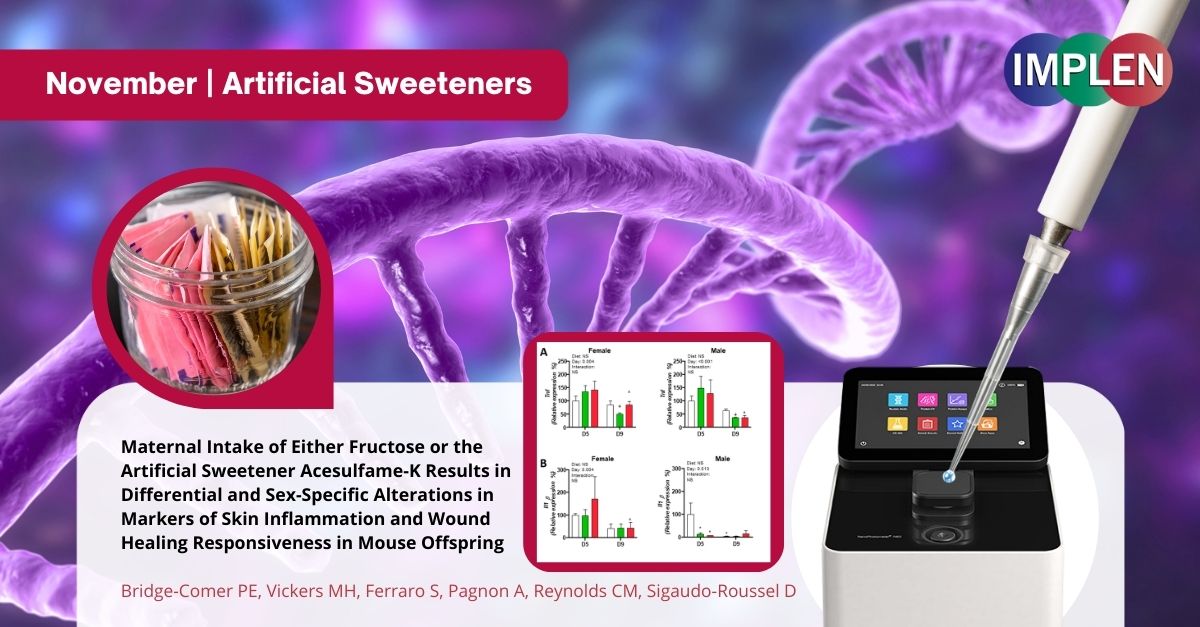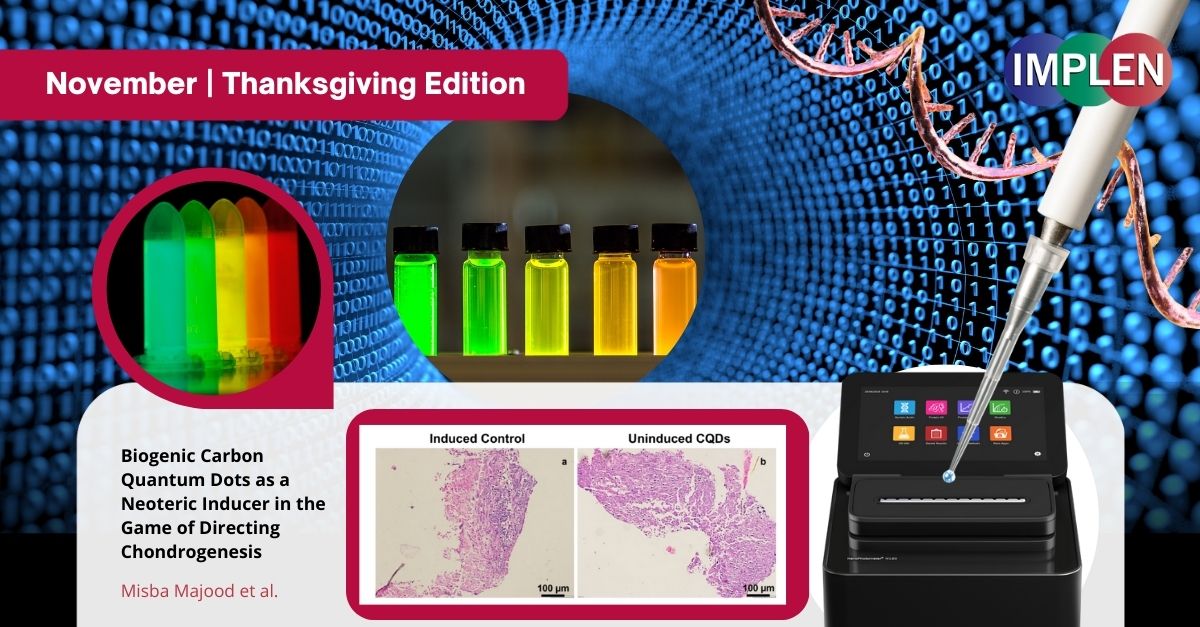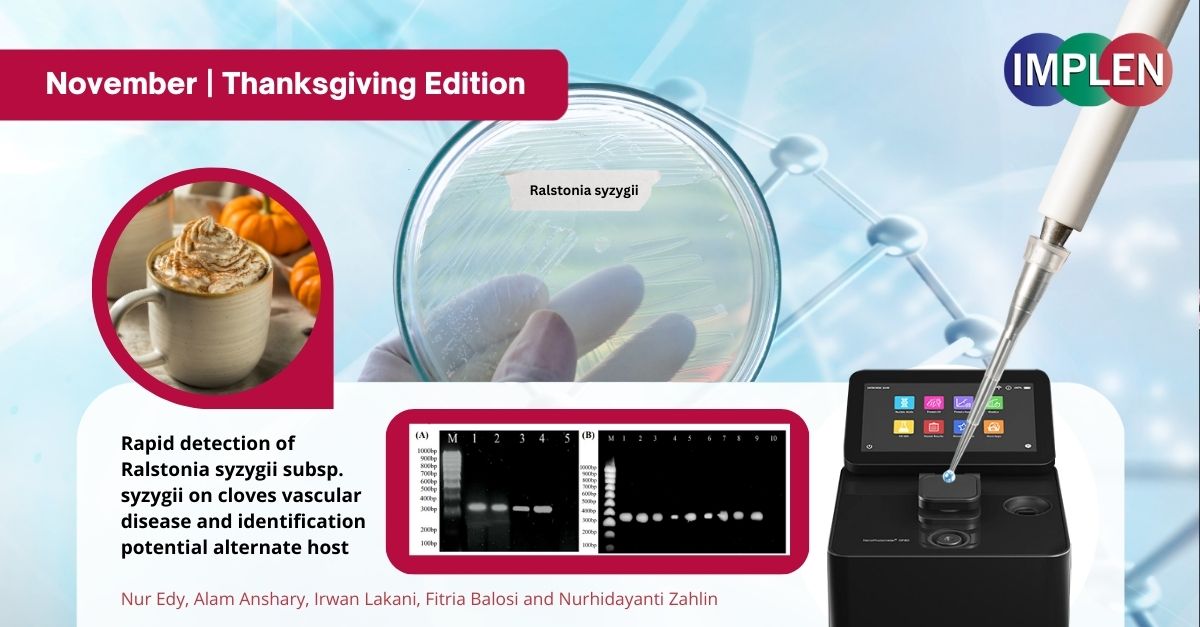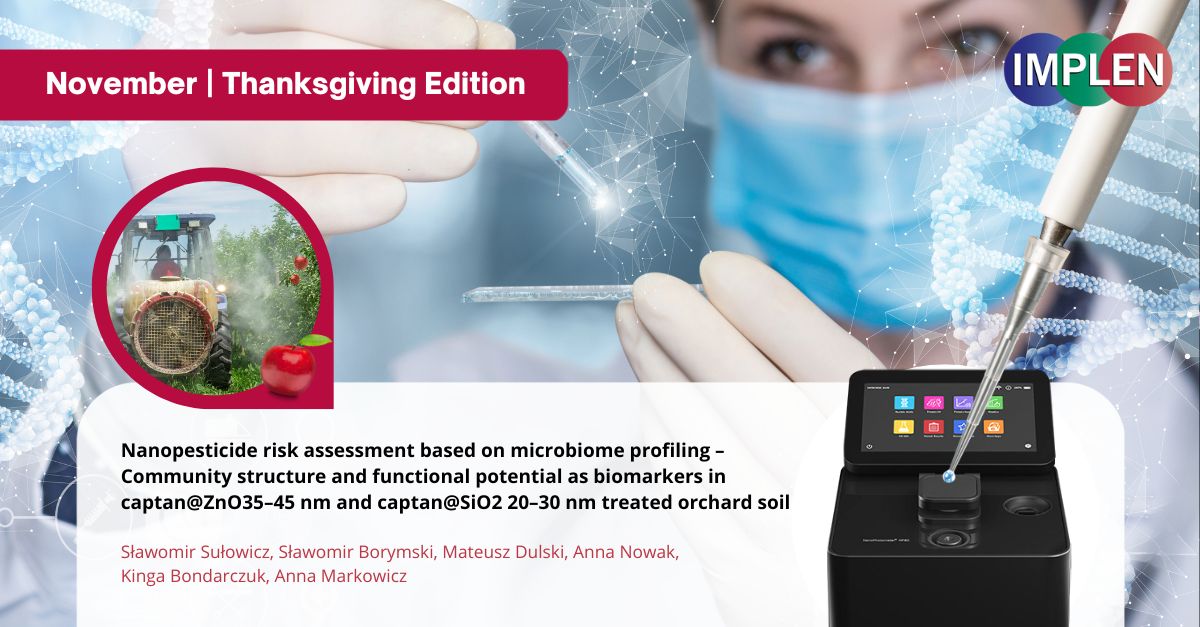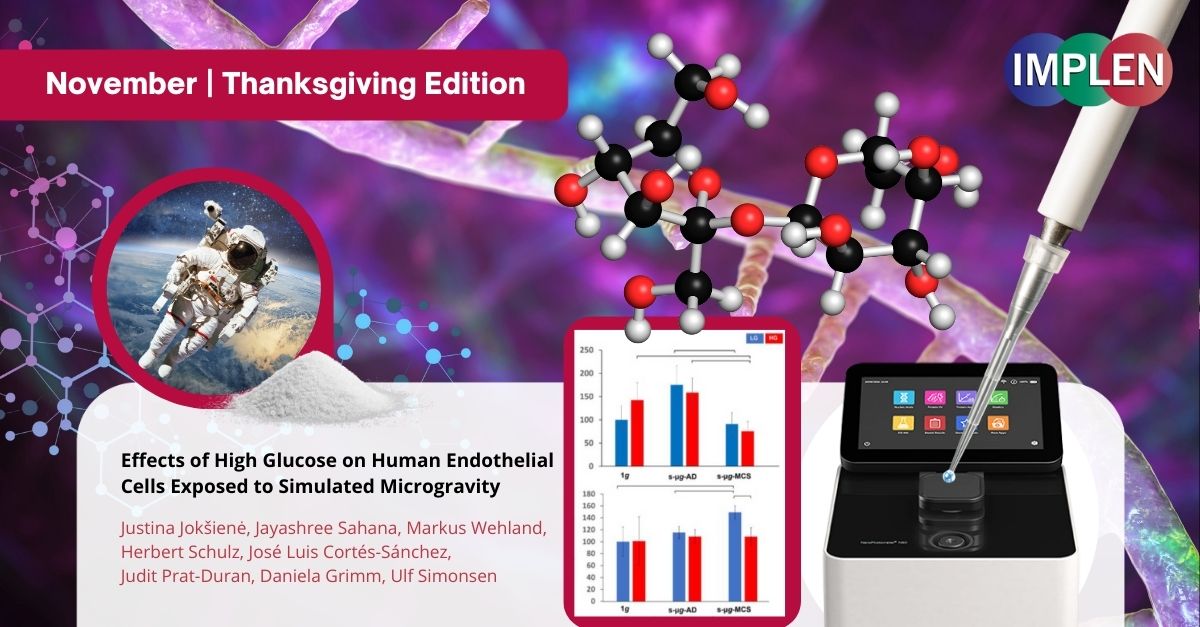Implen Journal Club | November Issue Thanksgiving Edition |
|
Sugar substitutes may have surprising health effectsThe first issue of The Journal Club is investigating the swap for sugar with artificial sweeteners this holiday season. Many parents try to limit their kids' candy intake by swapping in artificial sweeteners, but new research suggests these sugar substitutes may have surprising health effects down the road. Bridge-Comer et. al recently published a study in the journal of Nutrients looking at how consuming added sugar or artificial sweeteners affects factors including inflammation and wound healing later in life. They tracked two groups of mice - one fed extra sugar during pregnancy and breastfeeding, and another fed the artificial sweetener acesulfame-K. Intriguingly, the offspring in the sugar group ended up with significantly larger wounds compared to the normal diet group when injured. The sugar also delayed early wound healing, though wounds ultimately closed normally. The artificial sweetener didn't affect wound size, but it increased inflammatory signals in the body prior to injury. Throughout the study, small but measurable changes were seen in inflammation and healing based on which supplement was consumed early on. The takeaway? Even subtle exposures to added sugar or artificial sweeteners during pregnancy and breastfeeding can potentially have lifelong effects on health. Consuming these supplements in early life impacted factors like skin inflammation and wound recovery down the road. While more research is needed, the message for Halloween is clear. Limiting candy is understandable, but swapping sweets for artificial sweeteners may not be the harmless switch some assume. Early life nutrition has lasting effects, so make sure treats in moderation this Halloween don't turn into tricks on your child's health in the long run. The NanoPhotometer® N60 was used in this study to assess RNA. |
|
Promising cartilage tissue engineering applications with the biogenic carbon quantum dots (CQDs)In the second issue, we celebrate the emergence of innovative biomaterials with immense potential in regenerative medicine. Majood et al. conducted groundbreaking research on biogenic carbon quantum dots (CQDs) derived from Citrus limetta peel extract. These CQDs exhibit unique optical and chemical properties, opening doors to diverse biomedical applications. Specifically, their potential to induce chondrogenesis, the process of forming cartilage tissue from mesenchymal stem cells, was explored. The synthesis of CQDs through a hydrothermal carbonization method was followed by comprehensive characterization. The study evaluated the CQDs' capacity to induce chondrogenesis using human adipose-derived mesenchymal stem cells (hADSCs). Various concentrations of CQDs were administered to analyze their effects on cell viability, proliferation, and chondrogenic differentiation potential. Encouragingly, the CQDs displayed excellent biocompatibility with hADSCs. Gene expression analysis revealed the upregulation of key chondrogenic markers—COL2A1, ACAN, and SOX9—in CQD-treated cells. This compellingly suggests that CQDs can effectively prompt chondrogenic differentiation in hADSCs. This research underscores the potential of biogenic CQDs as a promising candidate for cartilage tissue engineering applications in regenerative medicine, owing to their ability to promote chondrogenic differentiation. They stand as an appealing nanomaterial for such purposes. Furthermore, the NanoPhotometers® NP80 and N120 were utilized in this study to ascertain RNA's optical density and concentration. |
|
Early detection techniques contributing to identifying and managing the bacterium in non-clove hosts is crucial for halting its surreptitious spreadThe wonderful aroma of pumpkin spice in your coffee during the festive season might be at risk due to a covert plant disease. Cloves, celebrated for their aromatic and warm flavor, stand as Indonesia's leading agricultural export. However, a pernicious vascular disease is now jeopardizing clove production. This issue of the Implen NanoPhotometer Journal Club: Thanksgiving Edition is highlighting the work done by Edy et al. identifying the elusive cause of this spice affliction—a bacterium known as Ralstonia syzygii. Through an innovative, rapid genetic test, this bacterium was discovered lurking in the vascular system of infected clove plants. Analogous to how blocked arteries in humans can precipitate a heart attack, the obstruction of plant vessels by this bacterium can cause clove trees to wither and perish. This deleterious bacterium doesn't limit itself to cloves. This work included examination of a range of other plants, including tomatoes, bananas, and even weeds, leading to the surprising discovery: the bacterium was present in all of them, even without visible signs of infection. This indicates that the bacterium could migrate among various plant hosts, extending beyond clove fields. Tiny insects, which feed on plant sap, could be unwitting carriers, disseminating the clove bacterium across diverse plant species. Their role in the spread of this disease adds a layer of complexity to controlling the outbreak. The implementation of early detection techniques, including the genetic test developed in this study, could contribute to identifying and managing the bacterium in non-clove hosts is crucial for halting its surreptitious spread. So, while enjoying pumpkin pie this Thanksgiving, remember the relentless efforts of researchers striving to safeguard these essential spices. Their work ensures that these delightful flavors continue to grace our tables and holiday traditions. The NanoPhotometer® was used in this work to quantify DNA concentrations. |
|
Nano-scale pesticides may have benefits with less damageNext issue is highlighting research recently published in the journal of hazardous materials investigating the impact of two new types of nano-scale pesticides on soil microorganisms, using apple orchard soil as the test environment. The nano-pesticides contained the active fungicide ingredient captan bound to nano-particles of zinc oxide or silica. Sułowicz et. al. studied whether these nano-pesticides would have less harmful effects on helpful soil bacteria and fungi compared to regular captan fungicide. This study found the nano-pesticides did change the makeup of soil bacterial and fungal communities over a 100 day test period, decreasing the diversity of microbe species present. However, the effect was less severe than with regular captan fungicide applied alone. The silica nano-pesticide appeared safer overall for soil microbes than the zinc oxide version. Apple farmers want to keep healthy orchards to minimize harmful impacts on helpful soil microorganisms that keep the orchard soil fertile for growing productive, tasty apples. The nano-pesticides tested could provide pest control with less damage to tiny underground allies than current fungicides. Healthy soil means healthy apples for appetizing pies to share at Thanksgiving dinner. The research suggests nano-scale pesticides may have benefits, but need more testing to confirm advantages over current options. With thoughtful use, nano-pesticides could help provide bountiful, delicious apples for generations of fall feasts. The NanoPhotometer® NP80 was used to determine the concentration and the purity of DNA spectrophotometrically. |
|
Microgravity's diabetogenic effects during the long-duration space travelThe last issue in November Implen Journal Club is showcasing how the Implen NanoPhotometer® is blasting scientific analysis to new heights analyzing the effects of hyperglycemia (high blood sugar) on human endothelial cells in microgravity conditions to mimic the effects of spaceflight. The findings provide insight into potential risks to astronauts' vascular health. During holidays like Christmas, increased sugar intake through foods like eggnog and desserts can spike blood glucose levels. While orbiting Earth, astronauts simultaneously experience microgravity, causing cardiovascular dysfunction. The study recently published in biomolecules explored whether hyperglycemia worsens these effects. While microgravity itself disrupted cell scaffolding proteins, sugar transport, and inflammation—high glucose further increased oxidative stress and cell death pathways when combined with simulated space conditions. This manifested in larger, more numerous detached cell spheroids indicative of dysfunction. On Earth, excessive sugar intake already strains vascular endothelial cells through similar pathways. So, while holiday revelers may cautiously indulge, the study emphasizes extra diligence for astronauts concerning in-flight nutrition and physical exercise to mitigate vascular risks from microgravity and potential hyperglycemia. These molecular insights could guide development of countermeasures enhancing resilience against microgravity's diabetogenic effects during future long-duration space travel as humanity expands presence beyond Earth orbit. A key contributor to this interstellar research was the NanoPhotometer® N60, which enabled precise quantification of isolated RNA for subsequent analysis after hyperglycemic endothelial cells experienced simulated microgravity or normal gravity. The N60 was integral for quantifying nucleic acids fundamental to illuminating molecular risks to astronaut health and future interplanetary travel. |
©2023 Implen. All rights reserved.
